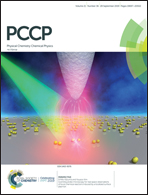Why does the presence of silicon atoms improve the emission properties of biphenyl derivatives? – Verification of various hypotheses by experiment and theory†
Abstract
In the course of studying silicon modifications to improve emission properties of commonly used organic compounds, biphenyl with dimethylsilylvinyl groups in the para position (3-Si) was investigated. A comparative study was performed on the exact C-analogue (3-C) and expanded to biphenyl and dimethylbiphenyl to emphasize the general trend observed. Compound 3-Si displayed emission properties clearly different than all of the investigated hydrocarbon compounds, i.e. twice stronger fluorescence (Φf = 0.6) and a 3-times larger radiative rate constant as compared to 3-C in acetonitrile. Searching for the source of the unique emission of 3-Si, singlet and triplet processes were investigated for all of the compounds using steady-state and time-resolved methods, and their principal photophysical parameters are reported. Experimental work was supported by the theoretical predictions obtained using the EOM-CCSD method. The results led to the conclusion that the strong emission of 3-Si must be due to silicon's presence that enhanced intensity borrowing from the strongly allowed S0 → S2 transition and the larger S1 → S0 transition moment.



 Please wait while we load your content...
Please wait while we load your content...